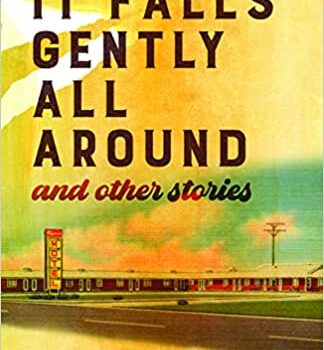 The buffalo blocked the two-lane road. Barely six-years-old, I had no notion of the rarity of this intimate sighting. In the distance a herd of the mythic beasts gathered in clumps across the Oklahoma reservation to eat pale, ankle-high prairie grass. The car’s engine hyperventilated in a get, get, get rhythm. The open sky and expansive plains mocked us. My mother sheepishly honked the horn once or twice, but the buffalo (technically a bison) held its ground. It may have been five or fifteen minutes until she finally surrendered and cut off the engine.
The buffalo blocked the two-lane road. Barely six-years-old, I had no notion of the rarity of this intimate sighting. In the distance a herd of the mythic beasts gathered in clumps across the Oklahoma reservation to eat pale, ankle-high prairie grass. The car’s engine hyperventilated in a get, get, get rhythm. The open sky and expansive plains mocked us. My mother sheepishly honked the horn once or twice, but the buffalo (technically a bison) held its ground. It may have been five or fifteen minutes until she finally surrendered and cut off the engine.
The next time I saw roaming buffalo was more than four decades later in Caprock Canyon, a remote state park in Texas. The buffalo ran toward a lake for their morning drink in early July as we circled the park both searching for them and surveying the available hiking trails. Again, a regal beast blocked the road. Behind the lake, brown lumpy hills of short grass and Mesquite transformed into orange-red cliffs dotted with green. The buffalo came and went as they pleased, and soon I realized we were the ones in the way. But it wasn’t until that moment that I recalled the first encounter in the avocado-green Oldsmobile accompanied by my mom, my grandmother, and the friend we were visiting.
I’m no expert on the brain, but I wonder about such trigger points and the workings of memory. I especially wonder about them in connection to writing, how on the best days the words flow and unexpected links appear, as though risen from the dead. Such memories do seem to move like ghosts across my mind, the actor in those memories both me and not me. Specific details often elude, but the feeling and some truth of what happened remains.
I’ve read that our brains experience a recalled moment the same as if it is happening in real time. That the brain can accomplish this feat hints at the illusory nature of time and the connectedness and layering of experience. Amazing, yes, but the downside of the brain’s indiscretion is not without trepidation; there’s plenty most of us don’t want to relive, but for writers maybe there’s an upside. During the process of telling a story, we are given the opportunity to make more sense of derailed experiences, the ones that both wounded and defined us. Maybe writing allows us to grapple with those experiences in more satisfying ways, even if the result remains the same.
After I began writing this, I went to New Mexico for a weekend. While there, a dear colleague, who is part of indigenous culture, gave me and several others a buffalo tooth. She knew nothing about the large animals recently populating my memory when she told us the buffalo is a sacred animal, majestic and symbolic of gratitude, abundance, and blessing. Recalling the buffalo at Caprock Canyon and the one that blocked the road when I was young, I can understand why our indigenous neighbors ascribe greatness and meaning to the brown-bearded giant, an animal capable of running 35 miles per hour and surviving harsh winters. An animal capable of surviving near-decimation in the nineteenth century and reclaiming its place in the world.
It’s strange how a new event can call past memories through a different doorway where a new light catches the hidden layers, revealing what we didn’t know at the time and assigning deeper meaning to what we do know. Much understanding seems to pivot on these moments of illumination. I didn’t know until my grandmother died, for example, that she wrote the occasional essay or poem, which deepened my understanding of those moments when she encouraged me to write.
In his book Narrative Design Madison Smartt Bell discusses modular design. Bell says, “What modular design can do is liberate the writer from linear logic, those chains of cause and effect, strings of dominoes always falling forward.” He goes on to say that modular design has less to do with motion and more to do with shapeliness. And he mentions that “modular design allows the writer to throw off the burden of chronology, as much as possible.”
Although Bell is referring to structure in fiction, it seems to me these observations might just as easily apply to nonfiction. Perhaps this is something many nonfiction writers know, but as someone who’s written mostly fiction, I was struck by an idea: Modular design, with its ability to move more freely, to be shuffled and reorganized, may come closest to mimicking memory, which is anything but chronological.
That a structure might exist to corral memory is appealing, though I’m hesitant to completely let go of its wildness. Lately, memory seems to me its own bearded beast, both majestic and mysterious in its ability to run alongside our lives when we are not paying attention, and to help us see and make connections when we are.



 We are proud to announce that past contributor Ramona Reeves from
We are proud to announce that past contributor Ramona Reeves from The buffalo blocked the two-lane road. Barely six-years-old, I had no notion of the rarity of this intimate sighting. In the distance a herd of the mythic beasts gathered in clumps across the Oklahoma reservation to eat pale, ankle-high prairie grass. The car’s engine hyperventilated in a get, get, get rhythm. The open sky and expansive plains mocked us. My mother sheepishly honked the horn once or twice, but the buffalo (technically a bison) held its ground. It may have been five or fifteen minutes until she finally surrendered and cut off the engine.
The buffalo blocked the two-lane road. Barely six-years-old, I had no notion of the rarity of this intimate sighting. In the distance a herd of the mythic beasts gathered in clumps across the Oklahoma reservation to eat pale, ankle-high prairie grass. The car’s engine hyperventilated in a get, get, get rhythm. The open sky and expansive plains mocked us. My mother sheepishly honked the horn once or twice, but the buffalo (technically a bison) held its ground. It may have been five or fifteen minutes until she finally surrendered and cut off the engine.